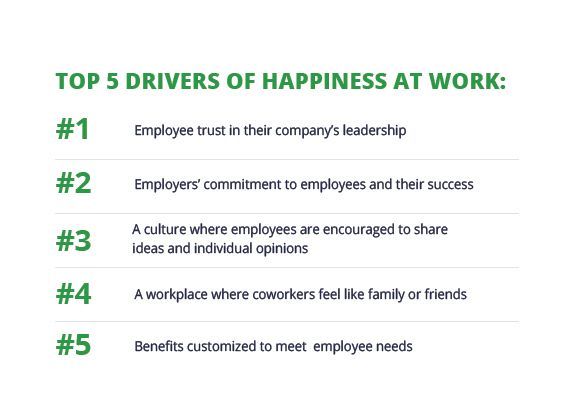Blog
Enhance Your Corporate Culture with Employee Benefits
Google. REI. Edward Jones. Zappos. Costco. Salesforce. What do these firms have in common? Do they all have ping pong tables, free lunches, tuition assistance, and flextime? No. They have company cultures that attract employees, making them a "Best Places to Work" employer.
You can have the best employee benefits on the market, but if no one wants to work for you, you won't be in business very long. Does a great company culture always provide great benefits? Do great benefits mean you're a top rated employer? It's time to understand the important link between culture and benefits and how your company can thrive on a good fit between the two.

What is Company Culture?
The concept of organizational culture first arose in academia the 1960s. The term "company culture" gained traction in the 1980s, and became ingrained in business language during the 1990s.
The term is used to describe organizational beliefs and norms, expectations and behaviors, management behavior and strategy, and finally expectations for how employees should act within the organization.
Norms, values, beliefs, and actions are demonstrated when the company interacts with the outside world. Customers, vendors, and business partners become acutely aware of the organization's identity and how they must interact with it.
Company culture has been studied to better understand how a company can consciously create a workplace where employees will thrive and customers become raving fans. A Harvard Business Review article by John Coleman identified six aspects of Company Culture that can be specifically addressed and designed for 20% to 30% better performance over competitors.
- Vision: Provide a specific purpose for the organization that guides all actions. (Alzheimer's Association's "A world without Alzheimers')
- Values: Guidelines on behaviors and mindsets to achieve the vision (Google's is "Don't be evil.")
- Practices: Criteria that are included in company policies and procedures to achieve the vision and values (Wegman's Supermarkets "A job you'll love.")
- People: Top firms have tough recruiting processes to ensure employees are a good "fit." (Zappos will ask the airport driver if the job candidate was nice to them.)
- Narrative: Storytelling creates a memorable impression. Sharing how your company got started, a speech by the founder, or artifacts throughout the office make a great impression. (Coca Cola's "World of Coke" display)
- Place: Whether you have an open office layout, closed office doors, or a bullpen, or 12 international locations your company's physical space says a lot about your culture. (Millennial leaders think open offices are too distracting—expect a changing office landscape.)
While corporate leaders work hard to create a company culture that is productive and profitable, we have to remember that culture is about people and how they can thrive in that culture.

Source: MetLife, "Thriving in the New Work-Life World," 2019
HR's Role in Corporate Culture
Once a company culture is defined, much of the responsibility for implementing it falls on the HR department. Not only do they need to be living examples of corporate values, they must recruit people and administer policies that are in alignment with the culture.
Never is this more challenging than recruitment. Not only must HR find talent that have the required experience and skills, they must also vet for intangible "fit" with the organization.
This is where employee benefits play a role. A candidate's "fit" is not just an accumulation of their skills and work history, but of their personal desires and needs. While a personality profile can identify their inherent motivations, most candidates (and employees) have something in common.
They need to take care of themselves and their families. They need to maintain their health on all levels—physical, mental, and financial—or they will be unable to work. While they might want to work for a company with a great culture, they need to work for an employer who will help them take care of their health, family, finances, and lifestyle needs.
It falls upon HR to administer a benefits plan that reflects the company's mission, values and narrative, while taking care of their people. The corporate benefit plan isn't just another recruiting tool—it keeps the company culture alive.
It's no wonder why the top employee benefits are health insurance (medical, vision, dental) and time off (flex time, paid vacation, work from home). Companies that offer these benefits show respect to their employees, which in turn will keep them working longer and be highly engaged.
"Employees need an ally, and employers can play this role by creating a workplace that not only recognizes employees holistically, but supports them holistically as well. One that provides experiences that enrich, a culture that accepts, and guidance that helps employees reach their individual goals." MetLife Employee Benefit Trends Study, 2019
Can you have a good culture—and bad benefits?
An unexpected competitor in today's job market is the gig economy. More people are choosing the flexibility to work remotely doing work they enjoy, even though it may mean less money and stability. A recent study indicated that 23% of currently employed individuals are considering leaving their present job for a gig because:
- Higher salary: 49%
- More/better benefits: 29%
- More flexibility in schedule: 27%
- More flexibility in working location: 27%
This indicates that people are willing to leave their job for a gig because they aren't getting the benefits they need in the workplace.
HR and recruitment teams spend valuable time identifying and hiring the right candidates. SHRM reports that the average cost to hire an employee is $4,129 per employee and takes 42 days.
When the wrong benefits are in place, you can't keep the employee, and you lose the valuable investment in time, energy, and productivity.
Benefits play a key role in attracting and keeping valued staff members. That is why many companies understand that they play a significant role in helping their employees both on and off the job and invest in benefits to keep them for the long term.
Financial health is a key benefit that is growing in popularity. While employers have offered 401(k) plans that up to 70% of employees typically participate in, new financial wellness programs include tuition assistance and student loan payoff programs. These programs can go a long way to helping ease financial stress, which nearly 30% of employees admit to feeling while on the job.
What if you can't afford top of the line benefits? Employees also value appreciation, recognition, important work, and contributing to a greater cause. Corporate values that are practiced each day are key to keeping employees on the job, even though you can't offer as many benefits as your competition.
Do Your Benefit Plans "Fit" Your Culture?
Wondering if your employee benefit plans reflect your corporate culture? If you want to attract more candidates, engage your employees, and retain your top talent, have a conversation with Woodruff Sawyer. We'll review your business objectives and the environment you want to create to make sure your benefit plan reflects your vision, values, and people.
Table of Contents










